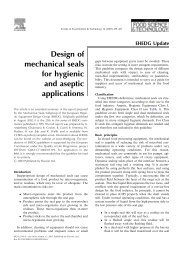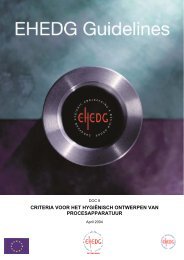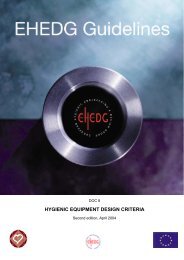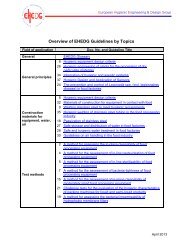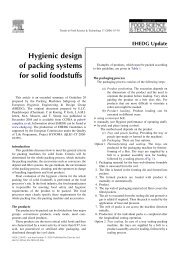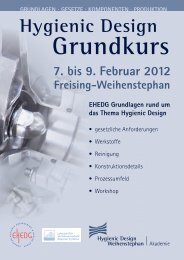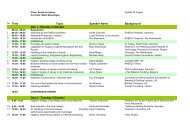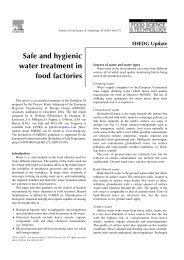Yearbook 2013/2014 - ehedg
Yearbook 2013/2014 - ehedg
Yearbook 2013/2014 - ehedg
You also want an ePaper? Increase the reach of your titles
YUMPU automatically turns print PDFs into web optimized ePapers that Google loves.
Examination of food allergen removal from two flat conveyor belts 113<br />
Figure 5. Steam vacuum chamber installed on the conveyor.<br />
(Photo provided courtesy of AmeriVap.)<br />
Reveal 3-D peanut, soy, and egg test kits (Neogen) were<br />
used to validate the effect of allergen cleaning. Each kit<br />
contains a sterile cotton swab, buffer solution, a sample<br />
tube, and a Reveal 3-D test device. The standard testing<br />
protocol provided by Neogen was followed. The device<br />
was read five minutes after reaction. The allergen<br />
acceptable limit was determined by the testing kits’ supplier<br />
to be < 5 ppm.<br />
The effect of allergen cleaning was tested on each belt.<br />
Each allergen-belt combination was tested three times with<br />
six swab samples each time for a total of 18 samples.<br />
Table 1. Allergen testing results on fabric-reinforced flat belt.<br />
Replication Allergen<br />
Peanut Soy Egg white<br />
1 4/6 0/6 0/6<br />
2 5/6 0/6 1/6<br />
3 5/6 1/6 0/6<br />
Total 14/18 (78%) 1/18 (6%) 1/18 (6%)<br />
As shown in Table 1, after dry-steam vacuum cleaning<br />
on the fabric reinforced flat belt, 78% of the samples<br />
tested positive for peanut, 6% tested positive for soy, and<br />
6% tested positive for egg whites. Allergens were not<br />
satisfactorily cleaned, especially for peanut butter, using<br />
this steam-cleaning system.<br />
Table 2. Allergen testing results on homogenous smooth urethane<br />
flat belt.<br />
Replication Allergen<br />
Peanut Soy Egg white<br />
1 0/6 0/6 0/6<br />
2 0/6 0/6 0/6<br />
3 0/6 0/6 0/6<br />
Total 0/18 0/18 0/18<br />
As indicated in Table 2, the three allergens were effectively<br />
removed from the solid smooth surface of the urethane flat<br />
belt using the steam vacuum cleaning device.<br />
Discussion<br />
The results of the allergen cleaning tests using the steamvacuum<br />
system clearly demonstrate that allergens cannot<br />
be removed from fabric-reinforced flat belts to a level<br />
where it cannot be detected with the applied test method<br />
with its specific detection limits, using the system. This<br />
was consistent with the testing carried out by Al-Taher et<br />
al. (2011) on urethane-faced fabric belts using a dry-steam<br />
cleaning device to clean peanuts, non-fat milk, and whole<br />
eggs. The results showed that no egg soils were detected –<br />
with the method applied – for all the cleaning times tested,<br />
while peanut and milk soils were still detected after cleaning<br />
the belt for 10 minutes using the same test kits as used in<br />
this study. The results also demonstrated that the efficacy of<br />
the dry-steam-cleaning unit on fabric flat belts depends on<br />
the type of food soil applied to the belt surface, which was<br />
also in agreement with the results obtained in this study –<br />
that peanut butter was more difficult to clean than soy and<br />
egg whites.<br />
On the other hand, the smooth, solid homogeneous<br />
urethane belt employed in this study showed effective<br />
removal of all allergens using the same cleaning system as<br />
the fabric flat belt. The difference with respect to allergen<br />
cleaning could be due to the belt’s homogenous surface<br />
properties, which fully meet the requirements for hygienic<br />
design of equipment developed by GMA. The fabricreinforced<br />
flat belt’s thin, laminated surface may not be<br />
fully enclosed, which could entrap allergen molecules. In<br />
addition, the fabric materials on the belt’s back side can<br />
absorb moisture accumulated from steam. The belt’s<br />
friction-driving mechanism allows that moisture to squeeze<br />
between the drum and the belt itself, which can result in<br />
allergens and other soils migrating to the top layer of the<br />
belt.<br />
In conclusion, the results from this study demonstrated<br />
that the newly developed solid-plastic flat belt can be used<br />
to reduce the potential allergen contamination during dry<br />
food processing in combination with the dry-steam vacuum<br />
system.<br />
Acknowledgement<br />
The authors are grateful to AmeriVap Company for allowing<br />
the use of their dry-steam cleaning unit to carry out this<br />
study.<br />
References<br />
1. The Food Allergy & Anaphylaxis Network (FAAN). Food Allergy<br />
Facts and Statistics for the U.S. www.foodallergy.org/files/Food<br />
AllergyFacts andStatistics.pdf. Accessed August 10, 2012.<br />
4. US Food and Drug Administration (FDA). 2011. The reportable<br />
food registration second annual report: Targeting inspection<br />
resources and identifying patterns of adulteration. www.fda.gov/<br />
Food/FoodSafety/FoodSafetyPrograms/RFR/ucm200958.htm.<br />
Accessed August 10, 2012.<br />
3. Branum, A., M.S.P.H. and Susan L. Lukacs, D.O., M.S.P.H. 2008.<br />
Food allergy among U.S. children: Trends in prevalence and<br />
hospitalizations. http://www.cdc.gov/nchs/data/databriefs/db10.pdf.<br />
Accessed August 10, 2012.



